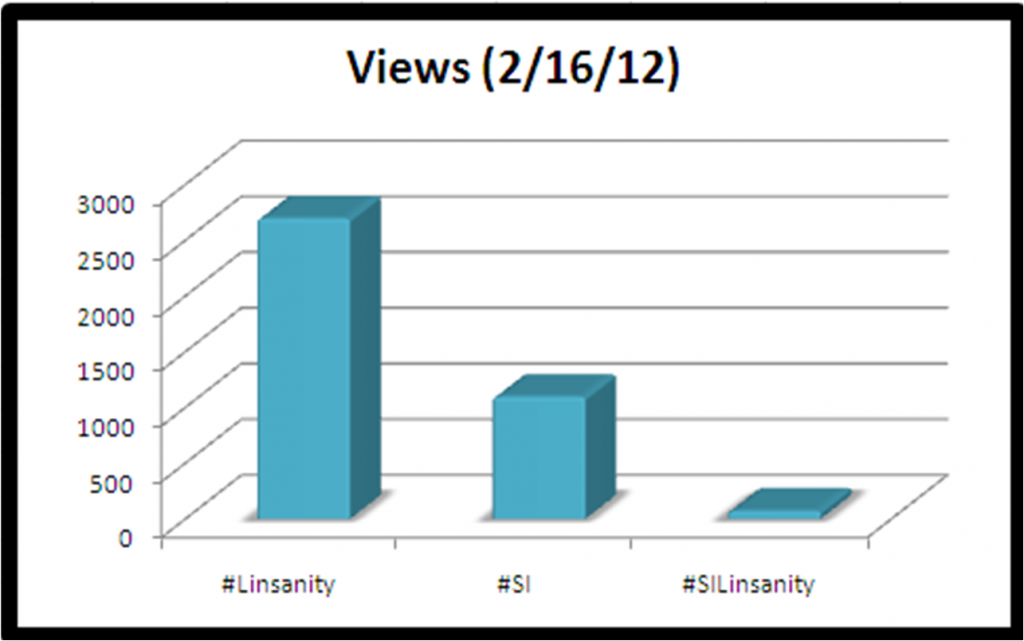Smashtags: Social Media Momentum Killers
Smashtags are destroying your social media momentum–and you might not even know what they are.
What is a smashtag?
A smashtag (patent pending*) is the combination of multiple words, topics, or subjects resulting in one long hashtag.
Awful examples:
#CocaCola2012Olympics
#TideBleach
#CapitalOneCupChampionship
#TylerAltrupIsAGenerallyGoodDude
Today’s Example: #SILinsanity
Instead of using #SI for Sports Illustrated along with #Linsanity for a reference to the Jeremy Lin craze sweeping the NBA, the sports magazine stalwart tried to smash them together.

(Almost) Never Start a Conversation from Scratch
So what, exactly, did Sports Illustrated do wrong? In short, everything.
Stop for a moment and ask yourself–what is the goal of using a hashtag? I would argue that the goal of using any hashtag, seriously or humorously, is to join in on an existing conversation or to start one. The former goal, finding and joining existing conversations, is straightforward and rewarding. The later goal, attempting to create a global narrative from scratch, is extremely difficult and strongly discouraged.
Failing to Define Goals or Meet Objectives
Back to the example: #SILinsanity
Sports Illustrated slapped this awful smashtag into a promotional video for a recent cover and failed to meet either of its probably objectives.
Let’s assume that SI had two objectives:
Objective 1: Promote the Sports Illustrated brand
Objective 2: Attach the brand to the Jeremy Lin craze
In a perfect world, I would have suggested that the brand make sure to use both #SI and #Linsanity in any promotion related to this cover. If they had done so, they would now be a searchable part of two massive conversations–one about Sports Illustrated and one about Jeremy Lin.

Instead, they failed to understand conversational mechanics and went with #SILinsanity, a conversation less than 1% of the size of the previous two.
Proof in the #Data #Pudding
Let’s take a look at some proof, delivered via simple Twitter hashtag data. These counts were pulled from the single-day data of Thursday, February 16. Over time, the results are even more pronounced.
#Linsanity: 2696
#SI: 1095
#SILinsanity: 72
Want more proof? How about a four-day track–see below for hashtag use from February 16-February 19.
I’d say that answers that question. The counts clearly illustrate the issue–#SILinsanity–despite broad promotion, simply does not have the social conversational traction of #SI and #Linsanity.
If You Build It, They Will NOT Come
The fundamental problem with hashtags is that a user will almost never go looking for them–or for whatever effort you have attached to them. If I want to see more from Sports Illustrated, I will search the full name or SI. If I want to find out about the craze surrounding the New York Knicks point guard, I will search for Jeremy Lin or Linsanity.
Users searching for any mix of these terms will completely miss #SILinsanity.
Smashtags do not work, they are not effective, and good social strategy requires that we change course by returning to our goals and objectives–and building a social communication plan that matches them.

*Not really
The Future of Social Analytics
Susan Etlinger (@setlinger), one of the most educated voices on social measurement, delivered the slides below at Adobe during Social Media Week 2012.
In short, I think that she nailed it. Her storyline accurately describes where social metrics is today and where it must go.
Here are my overall takeaways from her excellent presentation:
1. Account Proliferation is a Major Enterprise Challenge
Large enterprises now average over 170 different types of social and digital accounts. The good news is that business have embraced these new mediums–the bad news is that they have no idea how to manage or control this proliferation.

Proliferation is a difficult topic because there are clear benefits to a single voice but there are also benefits to engaging with niche communities via niche accounts. In my own experience, we delicately balance account creation by encouraging groups to first identify the goals of their accounts. This step often forces a marketer to make the key choice: create an account or leverage those that already exist.
2. Social Metrics Must Align to Business Metrics
Social ROI does not exist–nor do I believe that it will anytime soon. Regardless, organizations must begin to create three levels of metrics in my opinion.

Level 1: Social Counting Metrics
Social metrics are the easily collected data points–comments, likes, shares, views, etc. These are the least valuable but they must be aggregrated and tracked in order to move on to the two higher levels. I personally recommend Social Report as an affordable and comprehensive tool to do so. It aggregrates data from Google Analytics, Facebook, Twitter, YouTube, WordPress, and all of the usual suspects.
Level 2: Advanced Social KPIs
Social KPIs modify low-level social data into data points that are closer to real insight–metrics like reach, velocity, interaction rate, and others. These are all built on counting metrics but allow us to draw additional insight. These metrics start to allow marketers to take real action based on the data trends.
Level 3: Social Business Metrics
Susan makes an excellent point that social must start to align with broader marketing and business objectives. Social conversions, service issues resolved, and other metrics begin to take social interaction and align it with bottom-line activity. This must expand and become a pervasive part of each social team’s overall strategy. Call it what you will–Social Sales, Social CRM, Social Monetization–by any name it involves connecting social to the greater business.
3. The Era of Soft Marketing Is Over
I am exaggerating to drive the point home–but a big part of me believes this. The era of doing social marketing for the warm-and-fuzzies is over. Like all good marketers, social marketers must now make decisions based on strong data.
Furthermore, all marketers are now data scientists. A social measurement lead should set the agenda by implementing the strategy and teaching users the tools–but each marketer must take responsibility for understanding and employing this data.
Susan’s Two (Excellent!) Presentations:
6 Tips to Improve Twitter Link Click Through Rate
Dan Zarrella of Hubspot analyzed 200,000 tweets and drew the following conclusions about the success of various post components. Linda Bustos of Get Elastic took this one step further by breaking down each of the 6 tips here.
My translation of these tips:
- Aim for about 125 character tweets
- Place links in the first half of a tweet
- Always include a mention (@) and a hashtag (#)
- Use adverbs (profusely) to grab attention
- Create a good paper.li
- Make sure to tweet (or schedule tweets) during the weekend

Why CRM Planning is Broken
Customer Relationship Management (CRM) systems have been around for years and they offer unparalleled process automation. But…planning for them is broken.
Why/how are they broken?

Simple: We think of the system, not the customer. When planning for the next update to any organization’s CRM systems, we must think of what we want to know about our customers and not what the system will allow us to collect.
What do we really want to know about your customers?

My list, to start the conversation:
- Comments about:
- Us
- Our competitors
- Our products
- Our industry
- Engagement
- Web paths
- Clicks
- Content interest
- Impact of social impression
- Correlations
- Causation
- Better statistical analysis in general
- Influence
- The grey ghost, I know, but I still want it
What do you want to know about your customers/prospects/audience members? Leave a note in the comments section or let me know @TylerAltrup.
Improve the Timing of Your Social Media Posts
I stumbled upon this interesting post this morning–an excellent infographic from Kissmetrics based on data from @danzarrela.
Insights
1. Don’t Worry About Cali (aka Time Zone Awareness)
- Capture 81% of the US audience simply by optimizing for the Central and Eastern Time Zones
2. Tweet More, Facebook Less (per day)
- Post 1-4 times per hour to achieve higher click-through on Twitter
- Post 0.5 times per day to achieve higher click-through on Facebook Pages


